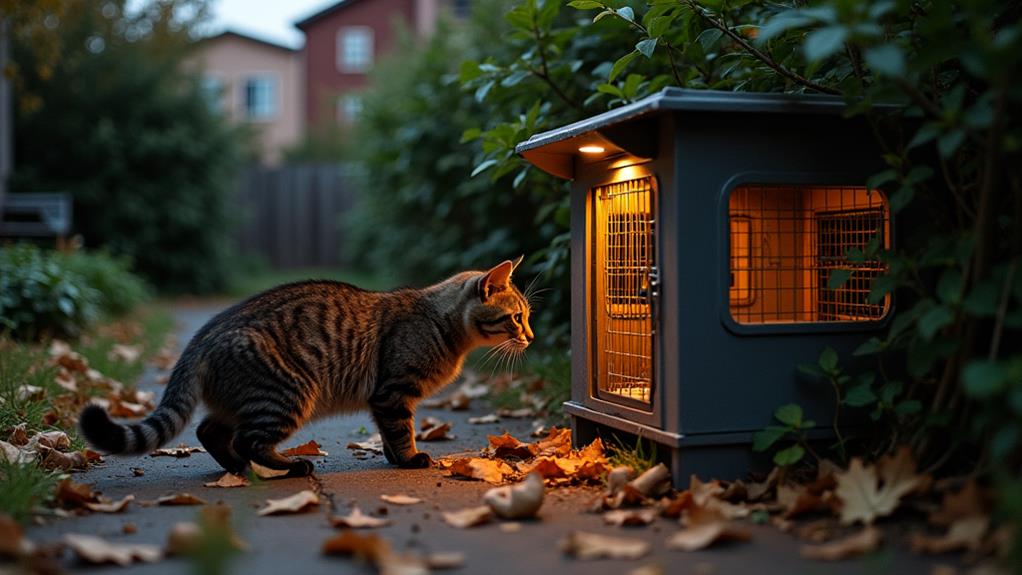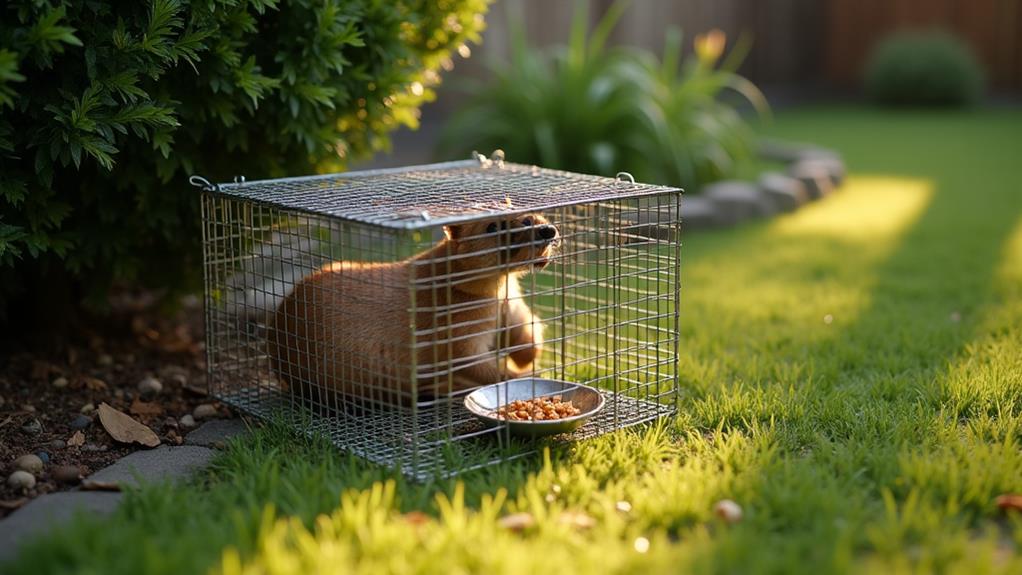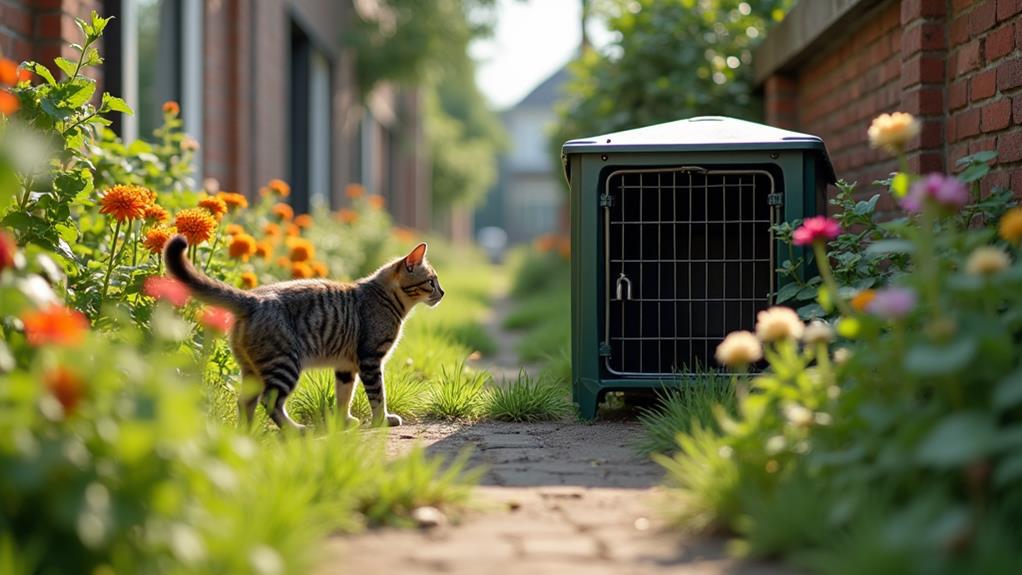How to Trap a Feral Cat for Neutering: TNR Made Easy

To trap a feral cat for neutering, start by establishing a consistent feeding schedule for 1-2 weeks in a secure area. Use this time to gather tools like humane traps and transportation carriers. Strong-smelling bait can lure cats into the trap effectively. Cover the trap with a blanket to keep the cat calm and monitor from a distance. Each cat should be transported in separate traps to minimize stress. After surgery, make sure the cat recovers in a quiet space. Eartipping helps identify neutered cats. These steps set the stage for a successful TNR effort with further insights available.
Understanding Trap-Neuter-Return
Understanding Trap-Neuter-Return (TNR) is vital for anyone looking to manage feral cat populations effectively. TNR is a humane approach that involves trapping community cats so they can be spayed or neutered, vaccinated, and then returned to their original location. This method is important because it prevents new kitten births and considerably reduces mating behaviors that often lead to conflicts and unwanted litters. Over time, this process helps stabilize and even decrease the feral cat population, creating a healthier environment for both the cats and the community.
Community cats, those often unadoptable due to their wild nature and lack of socialization, benefit greatly from TNR. Bringing them to shelters isn't ideal, as these cats face high mortality rates in such environments. Instead, TNR allows them to live out their lives in familiar surroundings while minimizing their impact on the local ecosystem. Many animal shelters now support TNR programs, recognizing them as a more humane and effective alternative to euthanasia.
To guarantee success in TNR efforts, you need to understand the local cat population's dynamics. Knowing their relationships and feeding habits will help you improve your trapping and management strategies, leading to a more effective TNR program.
Preparing for TNR
Before you commence a Trap-Neuter-Return (TNR) mission, preparation is key to guaranteeing a smooth and successful process. Start by establishing a consistent feeding schedule for at least one to two weeks before trapping. This helps feral cats become predictable in their movements and familiar with the area, increasing your chances of successfully capturing them. Choose a time that works best for you and stick to it daily, so the cats know when to expect food.
Next, gather all necessary equipment, including humane traps and transportation options. Practice setting the traps in advance to guarantee you're ready on the trapping day. When it's time to trap, use strong-smelling bait like canned cat food or tuna placed at the back of the trap to effectively lure the cats inside.
Secure a safe, warm, and dry holding space for the cats post-capture, facilitating their comfort and recovery after the spay and neuter procedures. Make sure to schedule spay/neuter appointments with a veterinary clinic that participates in TNR initiatives. Confirm that they can accommodate multiple cats in a single day, guaranteeing a streamlined and efficient process.
Engaging the Community

Someone once said that community support is the backbone of any successful Trap-Neuter-Return (TNR) program. Engaging your community is vital for fostering understanding and support for humane management of feral cat populations. Start by distributing educational materials, like TNR infographics, to dispel myths and promote awareness about the benefits of TNR programs. Simple, clear visuals can help clarify misconceptions and highlight the positive impact on your local area.
Host informational meetings or workshops to provide a platform for community members to voice concerns and learn about the TNR process. These gatherings can greatly increase participation and volunteer efforts, making your program more robust and effective. In addition, collaborating with local caregivers and residents improves data collection regarding the number and behavior of community cats, which is fundamental for effective trapping strategies.
Building positive relationships with neighbors is key. Address misconceptions proactively to foster trust and cooperation. This approach not only strengthens community involvement but also guarantees sustained support for ongoing TNR initiatives. By taking these steps, you'll create a network of informed and engaged individuals committed to improving the lives of feral cats and the community as a whole.
Setting a Feeding Schedule
Establishing a consistent feeding schedule is vital for successfully trapping feral cats for neutering. Start by choosing a reliable feeding area where you can provide food at the same time and location daily for about 1-2 weeks. This regular feeding routine helps cats develop a predictable feeding pattern, making them more comfortable and familiar with the area. Always include fresh water with the food to keep the cats hydrated. It's important for their health and encourages their return.
Once the cats are used to the schedule, remove any uneaten food promptly after feeding. This discourages other wildlife from visiting your feeding area and reinforces the routine for the cats. For especially skittish cats, consider placing unset traps during feeding times. This tactic allows them to acclimate to the traps without the stress of being caught, making the shift to setting the traps later smoother.
Position the feeding near the eventual trapping site. This association of the location with safety and nourishment enhances your chances of a successful capture. A consistent feeding schedule is your ally in gaining feral cats' trust and ensuring the neutering process goes smoothly.
Preparing Your Live Trap

With your feeding schedule firmly in place, it's time to focus on preparing your live trap for a successful capture. To begin, verify the live trap is the right size for feral cats, typically opting for a medium-sized one. Familiarize yourself with how it operates before setting it up. This will help you act quickly and confidently when the time comes.
To make the trap more inviting, line its bottom with lightweight cloth or newspaper. This not only offers comfort but also reduces the noise that might startle the cat when it steps inside. Next, choose a strong-smelling food like canned cat food or tuna as bait. Place this enticing food at the back of the trap, and consider creating a scent trail leading to the entrance using juice or oil. This can lure feral cats into the live trap effectively.
At the outset, position the trap away from their usual feeding area to not alarm them. Gradually move it closer as they get used to its presence. If using multiple traps, tag each one for identification and monitor them regularly to prevent prolonged confinement. This careful preparation will set the stage for a smooth trapping process.
Successfully Trapping Cats
Trapping feral cats successfully requires a blend of patience, strategy, and stealth. Start by establishing a consistent feeding routine 1-2 weeks before you plan to set the trap. This helps the cats become familiar with the area, increasing their comfort and the likelihood they'll enter the trap. Keep feeding them at the same spot and time daily.
When you're ready to set the trap, use strong-smelling bait, like canned cat food or tuna, to lure them in. A scent trail leading into the trap can also be effective in attracting the cats. Place the trap in the designated feeding area, but cover it with a blanket or tarp. This reduces stress and anxiety for any cat that gets trapped.
Once the trap is set, monitor it closely from a distance. This minimizes stress for the cats and guarantees they aren't left in the trap for too long. After a cat is trapped, cover the trap with a towel to help calm it. Transport the cat to a safe, climate-controlled area where it can await its neutering appointment. By following these steps, you'll effectively trap cats for the TNR process.
Neuter and Return Process

The Neuter and Return process, through careful planning and coordination, guarantees a smoother changeover for feral cats undergoing surgery. Initially, schedule spay/neuter appointments at clinics that specialize in community cat care. It's fundamental these clinics can hold cats overnight if needed after surgery. Each cat needs transportation in a separate live trap. This step is significant as it helps clinics process each cat effectively and minimizes stress during transport.
During the neutering procedure, eartipping is performed. This involves removing a small portion of the cat's ear to indicate the cat has been spayed or neutered and vaccinated. This identification measure is crucial for recognizing treated cats within the colony and avoiding unnecessary retrapping.
After the surgery, monitor the cats closely for any signs of complications. Follow any postoperative care instructions provided by the veterinarian diligently. Once the cats are alert and stable, typically within 24 hours post-surgery, they should be returned to their original colony site. This prompt return guarantees they can reintegrate into their familiar environment smoothly. The Neuter and Return process therefore effectively manages feral cat populations, safeguarding their health and wellbeing.
Post-Surgery Care
After a feral cat undergoes surgery, it's crucial to guarantee careful post-surgery care to promote a smooth recovery. Begin by providing a quiet and comfortable holding area, free from hazards. This minimizes stress and supports healing. Follow your veterinarian's post-operative care instructions closely, which might include managing the cat's pain and limiting their activities to make sure they have enough time to heal properly.
You should closely monitor the incision site for any signs of excessive bleeding, infection, or inflammation. These can indicate complications that need immediate attention. Be certain to check the site regularly, especially before considering release. A male cat can typically be released the day after surgery, but female cats usually require a longer recovery period. Always base the timing of their release on the veterinarian's advice and the cat's specific needs.
When it's time to release the cat, return it to its original colony site. Feral cats rely on their familiar environment for successful reintegration, so relocating them could disrupt their survival. By providing proper post-operative care and a timely release, you'll greatly contribute to the cat's well-being and the effectiveness of TNR efforts.
Expanding TNR Efforts

Expanding your TNR efforts can make a notable impact on stabilizing feral cat populations in your community. Begin by collaborating with local organizations like Alley Cat Allies. They offer resources and mentorship essential for implementing an effective TNR program. These partnerships can help you access significant tools and guidance, guaranteeing your efforts are strategic and successful.
Utilize targeted trapping strategies to establish larger kitten-free zones. This approach can markedly stabilize feral cat populations by preventing new litters, ultimately reducing the number of cats over time. It's not just about trapping as many cats as possible—focus on creating zones where cats are consistently trapped and neutered.
Community outreach is fundamental. Educate your neighbors about the benefits of TNR. When people understand how it reduces nuisance behaviors and improves public health, they're more likely to support and participate in your initiatives. Attend webinars and workshops to stay updated on the latest TNR techniques and best practices. This knowledge will improve the effectiveness of your efforts.
Lastly, advocate for local policies that support TNR. Community backing guarantees more sustainable and humane management of feral cat populations, making your work more impactful in the long run.




